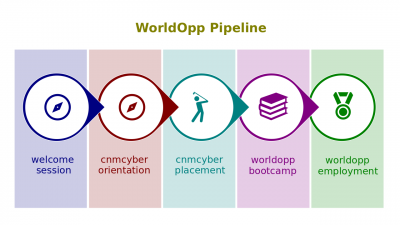Economy Segments
Economy Segments (hereinafter, the Lectio) is the second lesson part of the Industries and Specialties lesson that introduces its participants to industries, professional specialties, and related topics.
This lesson belongs to the Introduction to Employment session of the CNM Cyber Orientation. The Orientation is the second stage of the WorldOpp Pipeline.
Content
The predecessor lectio is What Economy Is.
Key terms
- Economy segment. An area of the economy. Two major conventional classifications divide enterprises in:
- Three groups, the public sector, private sector, and nonprofit sector, depending on their ownership.
- Three or four groups, the primary sector, secondary sector, tertiary sector, and, optionally, quaternary sector, in which enterprises are grouped based on a type of produced products. This classification also fits into economic phases of precedence, since lower levels of the economy emerged before higher levels and higher levels depend on lower ones. However, every enterprise usually produces some mix of products, so it can belong to several segments.
- Primary sector (primary degree of the economy, primary stage of the economy, raw materials industry). The economy segment that groups those enterprises that extract from nature, renew, and pre-process those raw materials or substances such as agriculture and mining products that the manufacturing industry will further process to create those goods and services that can be eventually consumed by end-users.
- Secondary sector (secondary degree of the economy, secondary stage of the economy). The economy segment that groups those enterprises that produce physical goods to be eventually consumed by end-users.
- Tertiary sector (tertiary degree of the economy, tertiary stage of the economy). The economy segment that groups those enterprises that produce physical, non-digital services such as retail, tourism, traditional banking, entertainment, etc.
- Quaternary sector (quaternary degree of the economy, quaternary stage of the economy). One of two:
- The digital industry or economy segment that groups those enterprises that produce digital products; OR
- The economy segment that groups those enterprises that do research and design new products.
Script
- Various segments of the national or international economy may be classified in numerous ways. Two of conventional classifications use the same term, sector, for their economy segments.
- Depending on their ownership, enterprises can be divided in the public, private, and nonprofit sectors.
- Depending on types of produced products, enterprises can be divided in stages of when the segment was historically launched.
- The primary sector or the primary stage of the economy is the raw materials industry that extract from nature, renew, and pre-process those raw materials or substances such as agriculture and mining products that the manufacturing industry will further process to create those goods and services that can be eventually consumed by end-users.
- The secondary sector groups those enterprises that manufacture physical goods to be eventually consumed by end-users.
- The tertiary sector groups those enterprises that produce physical, non-digital services such as retail, tourism, traditional banking, entertainment, etc.
- The quaternary sector may unite the information technology industry and those those enterprises that do research and design new products.
- No one classification is ideal. On the one hand, some can argue that the humanity historically launched the nonprofit sector first, followed by the public sector with the rise of royal states, and, eventually, the private sector. On another hand, one enterprise may produce a variety of products that may belong to different types. The concept of industries has been created to classify enterprises, and, therefore, employers, more specifically.
What Industry Is is the successor lectio.
Questions
Lectio quiz
- The answer is recorded for the lectio completion purpose:
- Among the primary, secondary, tertiary, or quaternary sectors of the economy, do you target any particular one for your future work? --Yes/No/I'm not sure/Let me think/More than one
